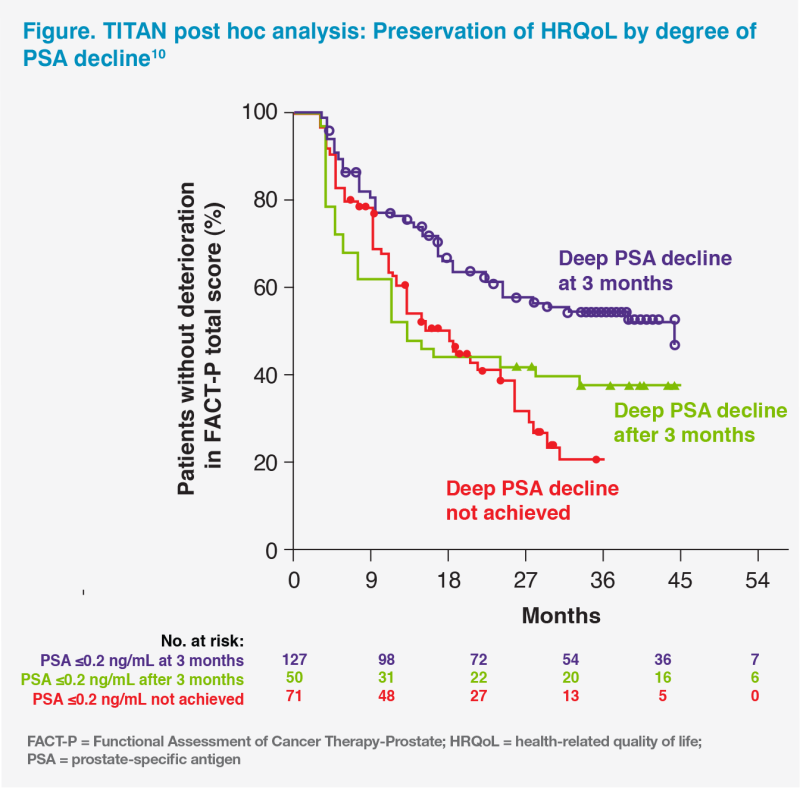Improvements in PSA, anaemia and performance status with ADT plus ARPI in a patient with mHSPC





History and presentation
A 71-year-old male ex-smoker and non-drinker presented with bone pain and back pain in March 2024. He had a past history of advanced squamous-cell carcinoma of the tongue that was managed with surgery and adjuvant chemoradiation in 2018. At presentation, his haemoglobin (Hb) level was 6.3 g/dL, indicating severe anaemia. He also had a raised alkaline phosphatase (ALP) level and a highly elevated prostate-specific antigen (PSA) level of 3,700 ng/mL.
An MRI of the spine did not show spinal cord compression. X-ray and FDG PET-CT imaging detected multiple bone metastases in the axial skeleton along with bone sclerosis, but no visceral metastases. Given the elevated PSA level and high volume of metastatic tumour burden, metastatic prostate cancer was suspected. Subsequently, a transperineal ultrasound-guided prostate biopsy (TPUS) confirmed adenocarcinoma of the prostate with an International Society of Urological Pathology (ISUP) grade group of 5.
When seen in May 2024, the patient appeared pale and had a Hb level of about 6 g/dL. His body weight was only 42 kg and Eastern Cooperative Oncology Group performance status (ECOG PS) was 2. He also had an enlarged prostate because of the primary tumour, which led to urinary obstruction.
Treatment and response
A doublet regimen of degarelix (androgen depravation therapy [ADT]) and apalutamide (an androgen receptor pathway inhibitor [ARPI]) was initiated in May 2024. Subsequently, the ADT component was switched to 3-monthly goserelin in June 2024.
The patient responded well to treatment with a reduction in PSA level to 50 ng/mL in July 2024. Despite this drastic drop in PSA, his lower urinary tract symptoms persisted. Simple palliative radiotherapy (21 Gy in 3 fractions over 1 week) was given to the prostate in July 2024, which alleviated his symptoms.
The patient was last seen in September 2024, 6 months after starting ADT plus apalutamide. Notably, his Hb level increased steadily over the 6 months to 9.5 g/dL, and his ECOG PS improved to 1. He gained about 1–2 kg of body weight, which is reasonable given his poor oral intake due to previous chemoradiation therapy to the tongue. So far, he tolerated the treatment very well without any adverse effects.
Treatment with ADT plus apalutamide is planned to continue until disease progression. In the meantime, the patient is being followed up every 2 months.
Discussion
Currently, there is no centralized prostate cancer screening programme in Hong Kong. As a result, a majority of cases present at an advanced stage, as did our patient who had multiple bone metastases, severe anaemia and bone pain caused by marrow infiltration.1 Although such high-volume metastatic hormone-sensitive prostate cancer (mHSPC) is considered incurable and has a poor prognosis, recent advances in systemic therapy have demonstrated survival benefits with early intensification of ADT and the addition of an ARPI (+/- docetaxel).2,3
According to international clinical practice guidelines, the current standard of care for mHSPC regardless of disease volume is doublet therapy (ADT plus apalutamide/abiraterone/ enzalutamide), while the standard of care for fit patients with high-volume disease is triplet therapy (ADT plus docetaxel plus abiraterone/ darolutamide).4,5 To optimize clinical outcomes, treatment intensification with ARPIs must be implemented early, before castration resistance develops.
Choice of doublet or triplet first-line treatment for individual patients is guided by volume of disease, timing of metastasis detection and patient-specific factors, such as age and comorbidities.2,4 We did not pursue triplet therapy for this patient as he had impaired bone marrow function and a borderline PS (partly due to previous chemotherapy for cancer of the tongue) at presentation. Therefore, doublet therapy with ADT plus apalutamide was chosen. In Hong Kong, use of apalutamide in the high-volume mHSPC setting is supported by the Samaritan Fund.6
In our clinical experience, apalutamide is generally well tolerated. Fatigue is relatively mild, does not impact daily living, and can be managed with exercise and change in diet. In fact, our patient became more energetic after starting apalutamide, likely due to a reduction in bone metastases and subsequent improvement in bone marrow function, as evidenced by an increase in his Hb level.
In the phase III, randomized, double-blind, placebo-controlled TITAN trial in patients with mHSPC (n=1,052), the addition of apalutamide to ADT significantly improved overall survival (adjusted hazard ratio [HR], 0.52; 95 percent confidence interval [CI], 0.42–0.64; p<0.0001) and radiographic progression-free survival (HR, 0.48; 95 percent CI, 0.39–0.60; p<0.001) vs ADT alone, whilst maintaining health-related quality of life (HRQoL). According to TITAN data, patients’ experience of pain and fatigue (intensity and interference) did not differ between the apalutamide and placebo groups for the duration of treatment.7-9
A post hoc analysis of patient-reported outcomes (PROs: Functional Assessment of Cancer Therapy-Prostate [FACT-P], Brief Pain Inventory-Short Form [BPI-SF], Brief Fatigue Inventory [BFI]) from TITAN showed that apalutamide-treated patients who, like our case, achieved a rapid and deep PSA decline (≥90 percent decline or PSA ≤0.2 ng/mL) at 3 months had prolonged preservation of HRQoL (as per total FACT-P) and physical well-being, as well as less pain and fatigue than those who did not.10 (Figure)

Whilst PSA is a useful tumour biomarker, other parameters, such as ALP, bone marrow function, and radiological evidence of progression, should also be considered when evaluating treatment response. Our patient experienced improvements in anaemia and PS after initiating apalutamide, implying improved HRQoL, which was reflected in his ECOG PS improving from 2 to 1 over the course of treatment.
Apalutamide is effective in a broad range of patients with mHSPC. In TITAN, all prognostic subgroups derived benefit from apalutamide regardless of disease volume, number of metastases and synchronous/ metachronous metastasis at presentation.11
Apalutamide is a strong inducer of CYP3A4 and is primarily metabolized by CYP2C8 and CYP3A4.12 Co-administration of apalutamide with modulators of these enzymes may result in drug-drug interactions, which are common across the entire ARPI drug class.13 Therefore, it is important to continuously review concomitant medications when a patient is receiving apalutamide.
In conclusion, ARPIs are most effective when used early in mHSPC treatment before development of castration resistance. Our patient presented with high-volume disease and severe anaemia. After being put on ADT plus apalutamide, he had a deep PSA response and an improved HRQoL.